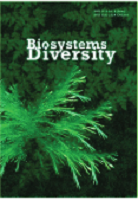Modeling the spatial variation of urban park ecological properties using remote sensing data
Modeling the spatial variation of urban park ecological properties using remote sensing data
Author(s): O. M. Kunakh, I. A. Ivanko, K. K. Holoborodko, O. I. Lisovets, A. M. Volkova, V. V. Nikolaieva, O. V. ZhukovSubject(s): Energy and Environmental Studies, Human Ecology, Environmental interactions
Published by: Дніпропетровський національний університет імені Олеся Гончара
Keywords: GIS-technology; human ecology; ecological monitoring; spatial ecology; vegetation indexes; urban ecology;
Summary/Abstract: Parks perform a wide range of ecosystem services in urban environments. The functional importance of parks depends on the composition and structure of the tree stand and the specific influence on soil and microclimatic conditions. The article reveals the dependence of soil and microclimatic properties on the structure of the crown space of a park stand. Spectral indices were also shown to be applicable for predicting the spatial variability of soil and climatic properties and indicators of crown space. Soil properties (temperature, moisture, and electrical conductivity in the 5–7 cm layer) and microclimatic parameters (light exposure, air temperature, and atmospheric humidity) were measured in the park plantation using a quasi-regular grid. The canopy structure and gap light transmission indices were extracted from the true-colour fisheye photographs. Thirty species of trees and shrubs were detected in the stand and understory. Robinia pseudoacacia L. was found most frequently (24.5% of all tree records). Acer negundo L. and A. platanoides L. were also frequent (12.4% and 15.5%, respectively). The first four principal components, whose eigenvalues exceeded unity, were extracted by the principal components analysis of the variability of ecological properties and vegetation indices. The principal component 1 explained 50.5% of the variation of the traits and positively correlated with the spectral vegetation indices. The principal component 1 reflected the variability of tree cover densities due to the edaphic trophicity. The principal component 2 described 13% of the variation in the feature space. This component correlated positively with the spectral indices. The principal component 2 was interpreted as a trend of vegetation cover variability induced by moisture variation. The principal component 3 described 8.6% of trait variation. It was most strongly correlated with the atmospheric humidity. An increase in atmospheric humidity was associated with an increase in the soil moisture and electrical conductivity and a decrease in the soil and atmospheric temperature. The principal component 4 described 7.5 % of the variation of traits. An increase in the values of principal component 4 was associated with an increase in the soil moisture and electrical conductivity and atmospheric moisture and was associated with a decrease in the soil and atmospheric temperature. The combinations of the trophotope and hygrotope create the optimal conditions for specific tree species, which is a condition for achieving the maximization of ecosystem services. The mineral nutrition conditions of plants and soil moisture exhibit spatial patterns that allow them to be considered in the design and management of park plantations. The ecological indices measured in the field were shown to be predicted using the vegetation indices. Multiple regression models were able to explain 11–61% of indicator variation. The regression relationships between markers of soil and microclimatic conditions and vegetation predictors are important for monitoring the condition of park plantations and evaluating the performance of park plantation management tools.
Journal: Biosystems Diversity
- Issue Year: 30/2022
- Issue No: 3
- Page Range: 213-225
- Page Count: 13
- Language: English

